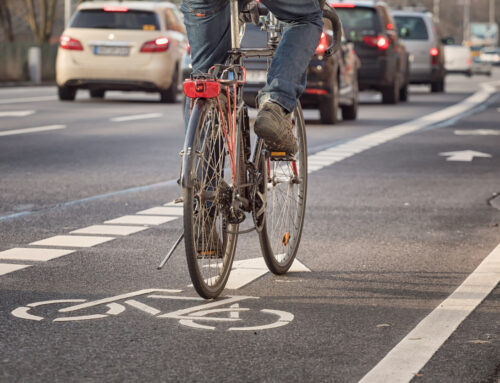Chicago has one of the highest populations of all U.S. cities, yet it also has one of the country’s worst bike safety rankings. Bicyclists in Chicago must contend with dense traffic, bike lanes that must be shared with larger vehicles, and poor connectivity.
As a result, it comes as no surprise that Chicago has a ways to go in reducing the city’s overall rate of bicycle accidents, injuries, and deaths. Looking at biking infrastructure concerns and bike crash statistics lends insight into where and how the city can make changes to support the safety of cyclists in Chicago.
A Look At Chicago Bicycle Accident Statistics
Thousands of bicycle accidents in Chicago have happened over the past two decades, several of which have had fatal outcomes for the cyclists involved.
Data from the city of Chicago monitoring bicycle crash stats for the most recent reporting year shows:
- An annual average of around 1,400 bike crashes
- An annual total of seven fatal bicycle crashes
- 145 cyclists suffering incapacitating injuries
- 826 cyclists suffering non-incapacitating injuries
- July is the month with the highest rate of bike crashes
In the past two most recent reported years, an average of 230 cyclists have been involved in July crashes, the month with the highest crash rate. The good news is this number has dropped significantly. In years before 2020, the average July crash rate was around 300 cyclists.
Chicago’s Bike Infrastructure Problem
Infrastructure concerns are a leading cause of Chicago’s high rate of bicycle accidents. Around 50 miles of Chicago’s bike lanes are designed for cyclists to share the road with other vehicles. Shared bike lanes can increase the risk of other drivers failing to notice cyclists on the road.
The majority of Chicago’s 130 miles of bike lanes are designed as dedicated bike lanes. However, safety concerns over how the city has implemented its bike lanes shed light on how these dedicated lanes still result in a high bicycle crash rate.
The primary issue with Chicago’s biking infrastructure is that its implementation often varies on a street-by-street basis. Many areas don’t offer a continuous dedicated lane for bikers. It can be challenging for bikers to safely navigate intersections, especially when they need to turn onto a different street.
In addition to inconsistent bike lane implementation, other safety concerns for Chicago bikers include the default city-wide speed limit of 30 mph and the lack of bike lane protection. Only about 9% of the city’s bike lanes offer barriers or other forms of protection that form a barrier between bicyclists and the vehicles they drive alongside.
Most Dangerous Locations For Bicyclists In Chicago, IL
Crash data from the city of Chicago also keeps track of where bike accidents happen most frequently across the city. This data helps identify which areas most need infrastructure changes that can better support cyclist safety.
The most dangerous areas for Chicago cyclists, based on crash data, include:
As city planners look toward creating a more cyclist-friendly city, these high-crash areas will be targeted, with the goal of reducing the rate of accidents that occur at these locations.
Other Leading Causes of Bicycle Accidents in Chicago, IL
Well-executed biking infrastructure goes a long way toward helping reduce a city’s rate of bicycle accidents. However, infrastructure isn’t the only factor that impacts how many cyclists end up involved in accidents.
In most cases, a biking accident results from an error by either the cyclist or a driver.
Some of the leading causal factors in Chicago bike accidents include:
- A driver speeding
- A driver not noticing a nearby cyclist
- Driving too close to a cyclist
- Opening a car door in the path of an oncoming cyclist
- A driver misjudging a cyclist’s speed
- Cyclists not making a complete stop at red lights or stop signs
- Cyclists not knowing or following bike lane rules
Increasing general safety knowledge, taking precautions, and showing vigilance are all tactics both cyclists and drivers can use to reduce Chicago’s bicycle crash rate.
How The City of Chicago Is Reducing Bicycle Accidents
Chicago is actively working to address its high rate of bicycle accidents. The city’s last major assessment of bicycle safety came over a decade ago in the form of its 2012 Bicycle Crash Analysis Summary Report.
While the report highlighted key findings that informed the development of city bike lanes over the past decade, the crash rate hasn’t improved. More recently, the city of Chicago released a new plan designed to further curb the city’s bike crash rate.
Chicago Cycling Strategy
In spring 2023, the city of Chicago released the Chicago Cycling Strategy. This comprehensive report serves as a combined assessment and action plan for helping make Chicago streets safer for cyclists.
The plan outlines new action steps the city is taking to make biking safer and more enjoyable for Chicago residents.
Plans from the Chicago Cycling Strategy include:
- Increasing bike lane connections between neighborhoods
- Upgrading existing lanes
- Filling gaps in the current bike lane network
- Extending the existing bike lane network into more neighborhoods
- Increasing the city’s number of low-stress bike routes
The new plans were designed to address the most pressing concerns with Chicago’s current biking infrastructure. They also aim to provide additional bike routes through green spaces, removing cyclists from busy roads and helping reduce the opportunity for accidents involving larger vehicles.
The state of Illinois also has 5,000 miles of state highway system that are considered suitable for cycling.
Chicago’s Public Outreach Programs
In addition to plans to make biking in Chicago safer, the city also has two public outreach programs to support cyclist safety and make biking accessible for more residents.
SAFE Ambassadors is a public outreach program that gives school presentations on traffic safety and offers learn-to-bike sessions for both adults and children. Bike Chicago is an initiative intended to make cycling safer and more affordable. The program is designed to distribute bicycles and safety equipment to Chicago residents.
A Safer Future For Bicyclists in Chicago, IL
Chicago is actively working to improve its biking infrastructure, with the goal of significantly improving the level of safety cyclists enjoy on Chicago city streets.
Cyclists and drivers alike can help support the goal of reducing the rate of bicycle accidents by staying alert and following basic traffic safety rules.










Leave A Comment